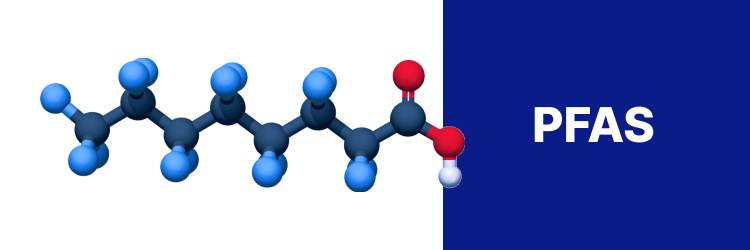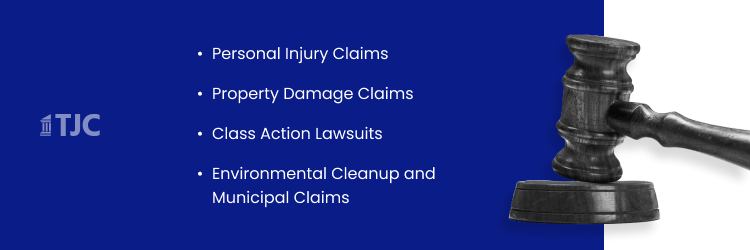Imagine chemicals so durable that they stay in our environment and our bodies for decades, potentially causing serious health problems and environmental harm. These are PFAS: per- and polyfluoroalkyl substances, often called “forever chemicals” because they don’t break down easily.
Used widely since the 1940s in everything from non-stick pans to firefighting foam, PFAS are now everywhere, from our drinking water to the food we eat and the air we breathe. Communities across the United States are now raising their voices about PFAS contamination.
Lawsuits have been filed against major PFAS manufacturers, seeking justice for the health risks and property damage linked to PFAS. As more people realize the effects of these chemicals, PFAS litigation has become one of the most significant legal battles in environmental and public health history.
We’ll explore the current status of PFAS lawsuits, the potential health impacts of exposure, and how those affected can take action. We’ll break down why PFAS lawsuits matter, what they involve, and what individuals can do if exposure has affected their health or community.
PFAS Lawsuit Status
PFAS cases are making headlines as communities seek accountability for decades of contamination. Many companies have faced lawsuits, but some of the most prominent are against 3M, DuPont, and Chemours, all major players in the PFAS industry. These companies produced or used PFAS for years, even as evidence grew that these chemicals could cause harm.
One of the most significant settlements occurred in 2023 when 3M agreed to pay $10.3 billion to resolve claims from public water systems contaminated by PFAS. This enormous sum highlights the scale of the problem: PFAS infiltration isn’t just a minor issue.
It affects millions of people across the country, particularly those relying on public water systems in regions where PFAS use has been heavy. This settlement is part of a multidistrict litigation (MDL) case, a process that combines similar lawsuits to streamline proceedings.
With thousands of plaintiffs and billions of dollars at stake, PFAS suits are complex, and cases continue to emerge. In addition to public water system claims, individuals and entire communities are filing lawsuits over contaminated water. They demand accountability from PFAS manufacturers and restitution for the damage.
The U.S. Geological Survey (USGS) recently released alarming data that estimates 71 to 95 million people in the United States rely on groundwater that contains PFAS levels. This finding has fueled further litigation and has encouraged regulatory agencies to look closely at the sources of contamination.
Communities in areas with high PFAS concentrations are leading the charge, pushing for stronger regulations and more rigorous cleanup standards. The legal process is long and often grueling, but recent settlements offer hope.
With billions of dollars allocated to address contamination, affected communities may finally get the resources they need for clean-up and medical monitoring.
What Are PFAS and Why Are They Harmful?

PFAS is a family of over 4,700 man-made chemicals created to make products that resist heat, water, grease and stains. Their use skyrocketed in the 1940s when manufacturers discovered their unique properties.
Forever chemicals quickly became indispensable, appearing in everything from water-repellent clothing to non-stick cookware. Known for their resilience, they’re now in hundreds of everyday products.
The chemical structure of PFAS is what makes them so effective and, unfortunately, so harmful. PFAS compounds consist of a chain of carbon-fluorine bonds, one of the strongest bonds in chemistry.
This bond strength means that PFAS don’t degrade under normal environmental conditions. Once they enter our environment—whether in soil, air, or water—they stay for decades, if not centuries.
Scientists have found PFAS in unexpected places: deep ocean waters, polar ice, and remote mountain ranges. These chemicals travel through air and water, making contamination difficult to contain.
PFAS accumulates in the environment and builds up in our bodies. Once ingested or absorbed, PFAS binds with proteins in the blood and can remain there for years.
The health impacts of PFAS exposure are concerning. Certain types of PFAS, like PFOA and PFOS, are linked to severe health effects. These chemicals are among the most studied PFAS due to their widespread use and persistence in the body.
Companies ceased production of these specific PFAS chemicals in the early 2000s due to safety concerns. However, since PFAS don’t break down, these substances continue to impact the environment and human health.
Health Risks and Environmental Impact of PFAS
PFAS contamination is a serious health concern. Scientists have studied the effects of PFAS on human health extensively, and the results are alarming. Here are some of the main health concerns:
Increased Cancer Risk
PFAS has been associated with various cancers, including kidney, liver, and testicular cancers. These cancers are particularly concerning because of the long latency period; PFAS may accumulate over time before causing noticeable health effects.
Studies conducted in communities exposed to high levels of PFAS have shown increased rates of these cancers, prompting more research into the link between PFAS contamination and cancer risk.
Immune System Effects
PFAS may impair the immune system, reducing the body’s ability to fight off infections. Some studies suggest that PFAS exposure could reduce vaccine effectiveness, a worrying prospect for children and individuals with compromised immune systems.
This impact on immunity has led researchers to question how PFAS contamination could affect public health, particularly during pandemics or flu seasons.
Reproductive Harm and Developmental Issues
PFAS have been shown to disrupt hormone function, affecting reproductive health. Pregnant women exposed to PFAS may experience complications, and studies indicate that children exposed to PFAS may have lower birth weights and developmental delays.
The CDC has highlighted the risks PFAS pose to pregnant women and children, emphasizing the need for more research into these developmental impacts.
Liver Damage and High Cholesterol
The liver processes toxins, and PFAS can place extra strain on this vital organ. Studies show that people with high PFAS levels in their blood often have elevated cholesterol and liver damage.
These health concerns are particularly relevant for individuals living in highly contaminated areas, such as communities near military bases and industrial sites.
The environmental impact of PFAS is equally devastating. These chemicals are widely detected in contaminated drinking water, especially near manufacturing facilities, firefighting training sites, and wastewater treatment plants.
One of the most notorious sources is firefighting foam, known as aqueous film forming foam (AFFF). AFFF was commonly used on military bases and in industrial areas to suppress fires, but it left lasting contamination in soil and water.
PFAS has severe consequences for ecosystems. Wildlife, particularly fish and birds, can accumulate high levels of PFAS, disrupting food chains and threatening biodiversity.
A study conducted in the Great Lakes region found that fish in PFAS-contaminated waters had levels of PFAS thousands of times higher than in other areas. Such findings underscore the far-reaching impact of PFAS on both environmental and human health.
PFAS Lawsuit Background
The history of PFAS suits dates back over 20 years. The first major lawsuit involving PFAS pollution was filed by residents near DuPont’s Washington Works plant in Parkersburg, West Virginia.
These residents claimed that DuPont had contaminated their drinking water with PFOA, one of the most common PFAS compounds. The case brought national attention to PFAS, leading to a class-action settlement and the creation of the C8 Science Panel to study the health effects of the forever chemicals.
The Environmental Protection Agency (EPA) became involved shortly after, issuing health advisories and initiating programs to phase out PFOA and PFOS, two of the most widely used PFAS chemicals. While these measures marked a step forward, PFAS production continued, and contamination remained widespread.
Several significant lawsuits followed, leading to multi-million and billion-dollar settlements. In 2017, DuPont and Chemours agreed to a $671 million settlement with residents of Parkersburg and surrounding areas.
This case set a precedent and established a framework for future PFAS legal disputes, showing that corporations could be held accountable for contamination and its health impacts.
The creation of multi-district litigation (MDL) has made it easier for affected communities to pursue claims. The MDL, based in South Carolina, combines thousands of lawsuits from across the country, allowing plaintiffs to share resources and evidence.
As lawsuits mount, states are also taking action. Several states have filed lawsuits against PFAS manufacturers, arguing that they should bear the costs of cleaning up PFAS-contaminated water and soil.
Some states, like California and New York, have enacted stricter PFAS regulations, setting lower acceptable limits for these chemicals in drinking water than federal guidelines.
PFAS Lawsuits Legal Basis
PFAS legal proceedings rely on a few key legal principles to argue that companies acted irresponsibly by manufacturing and distributing dangerous chemicals. Here’s an overview of the main legal grounds used in PFAS cases:
Negligence
Many lawsuits claim that companies knew or should have known about the health risks of PFAS but failed to act responsibly.
For example, internal documents from 3M and DuPont revealed that company executives were aware of the potential dangers of PFAS as early as the 1960s. This knowledge raises questions about corporate responsibility and the duty to protect consumers and communities.
Public Nuisance
Contaminating shared resources like drinking water is considered a public nuisance. This legal principle applies to PFAS trials, where plaintiffs argue that the presence of PFAS disrupts public health and welfare.
Public nuisance claims have been successful in cases where contamination affects an entire community or region, making it impossible for individuals to avoid exposure.
Failure to Warn
Lawsuits allege that PFAS plants did not adequately inform the public about the dangers of their products. For example, companies that produced firefighting foam did not disclose the risks associated with PFAS to firefighters and nearby residents.
Failure to warn claims are particularly relevant in cases where vulnerable populations, such as first responders and factory workers, have experienced high levels of exposure without adequate protection.
At the federal level, the EPA has implemented guidelines for PFAS levels in drinking water, though these are often advisory rather than enforceable standards. Some states have enacted stricter PFAS regulations than federal guidelines, providing additional legal grounds for plaintiffs.
Types of PFAS Claims and Lawsuits
PFAS suits cover a broad range of claims, from personal injury to environmental cleanup. Here’s a breakdown of the types of claims commonly filed in PFAS legal claims:
Personal Injury Claims
These lawsuits are filed by individuals who have developed health conditions linked to PFAS buildup. Common conditions include cancer, liver damage, and immune system issues. Personal injury claims often seek compensation for medical expenses, lost wages, and pain and suffering.
Property Damage Claims
PFAS pollution can reduce property values, especially in areas where groundwater is contaminated. Property owners in these areas may file claims to recover the loss in property value or cover the costs of cleaning up contaminated land. Property damage claims are essential for homeowners who may be unable to sell their property due to high PFAS levels.
Class Action Lawsuits
Class actions allow groups of people exposed to PFAS to file a single lawsuit collectively. This type of lawsuit is common in PFAS cases because contamination often affects entire communities.
Class actions allow large groups to hold companies accountable, especially when individual claims would be too costly to pursue alone.
Environmental Cleanup and Municipal Claims
Municipalities and local governments have filed lawsuits to fund environmental cleanup efforts. Many cities need to install advanced water filtration systems to remove PFAS from public water supplies, which can be expensive. Municipal claims are critical for protecting public health and ensuring access to safe drinking water.
Each type of PFAS lawsuit has a unique purpose. Together, they form a strategy to hold manufacturers accountable.
Potential Compensation
Compensation in PFAS trials is designed to address the extensive health, environmental, and financial impacts caused by contamination.
On average, settlements range from $175,000 to $350,000 per claimant, with amounts influenced by the severity of health impacts, duration of exposure, and quality of legal representation.
Larger settlements, like the recent class action approved in April 2024, could amount to between $10.5 to $12.5 billion, reflecting the widespread and costly implications of PFAS infiltration across communities.
- Medical Costs: Claimants can seek compensation for medical bills related to PFAS-linked conditions, especially severe cases like cancer.
- Property Value Loss: Many affected property owners receive compensation for the decrease in property values due to contamination.
- Environmental Cleanup: Settlements fund water and soil remediation efforts to restore safety in affected communities.
Take Note: Strong legal support, medical records, and exposure evidence can increase claim success and offer financial relief and accountability for those affected.
Noteworthy PFAS Cases and Settlements
The PFAS legal battle is marked by substantial cases, groundbreaking settlements, and significant court rulings.
Below, we’ll look at some of the most notable cases and settlements, their outcomes, and how they continue to shape the fight against contamination of these forever chemicals.
DuPont’s Washington Works Plant Settlement (2005)
One of the first major PFAS cases involved DuPont’s Washington Works plant in Parkersburg, West Virginia. Residents alleged that DuPont’s activities had contaminated their drinking water with PFOA, one of the most dangerous PFAS compounds.
- The Class Action: Over 3,500 people in six water districts around Parkersburg filed a class-action lawsuit against DuPont in 2001. They claimed that the company’s practices led to widespread chemical buildup in their water supply.
- Settlement: In 2005, DuPont agreed to a $70 million settlement. This amount included $30 million to fund a health study into the impacts of PFOA on local residents.
- The C8 Science Panel: A significant part of the settlement involved creating the C8 Science Panel to study the health impacts of PFOA. This panel conducted research from 2005 to 2013, eventually finding a “probable link” between PFOA exposure and six health conditions, including kidney and testicular cancer.
- Long-Term Impact: The findings from the C8 Science Panel have been crucial in subsequent PFAS cases. They provided the scientific foundation for future claims linking PFAS to health problems.
DuPont and Chemours Settlement (2017)
After the Washington Works plant settlement, DuPont faced further litigation. As more evidence emerged, DuPont and its spinoff company, Chemours, were held accountable for additional contamination.
- Class Action and Lawsuits: In 2017, DuPont and Chemours settled for $671 million with residents of Parkersburg, West Virginia, who had continued to experience health issues linked to PFAS residue.
- Allocation of Funds: This settlement compensated residents affected by PFAS and allowed for further environmental monitoring. Each company, DuPont and Chemours, agreed to pay half of the settlement amount.
- Significance: This case underscored the financial liability facing companies that produce PFAS, setting a financial benchmark for PFAS-related settlements.
3M’s $10.3 Billion Settlement with Public Water Systems (2023)
In June 2023, 3M reached a historic settlement to resolve claims from public water systems affected by PFAS contaminants. This case stands as one of the largest environmental settlements in U.S. history.
- Multi-District Litigation (MDL): The settlement was part of a broader MDL in federal court. This MDL included claims from thousands of communities, making it one of the largest coordinated legal actions against PFAS producers.
- Settlement Terms: 3M agreed to pay $10.3 billion over 13 years to public water systems across the U.S. This money will be used to treat PFAS-contaminated water, benefiting an estimated 4,000 affected water systems.
- Significance: This massive settlement is a turning point in PFAS litigation, underscoring the scale of contamination. It also sets a financial precedent, showing that companies may face significant costs for environmental cleanup.
Chemours, DuPont, and Corteva Settlement (2023)
In another significant 2023 settlement, Chemours, DuPont, and Corteva agreed to pay $1.185 billion to settle claims from water providers. This case further highlighted corporate accountability for PFAS pollution.
- Details of the Settlement: The settlement resolved claims from public water systems in the U.S. that had been contaminated by PFAS. The funds will support water treatment efforts and PFAS testing across communities.
- Cost-Sharing: Chemours agreed to pay 50 percent, DuPont 29 percent, and Corteva 21 percent of the settlement amount.
- Impact: This settlement demonstrates the ongoing liability facing PFAS plants and the increasing pressure to support remediation efforts. Like 3M’s settlement, it emphasizes the financial burden companies face in addressing contaminants from PFAS.
Kidde-Fenwal Settlement (2024)
In October 2024, fire safety equipment manufacturer Kidde-Fenwal reached a $615 million settlement. The company faced lawsuits for the contamination caused by firefighting foam containing PFAS.
- The Allegations: Kidde-Fenwal was accused of knowingly producing and distributing AFFF that contained dangerous PFAS chemicals. This foam was widely used by firefighters and military personnel.
- Settlement Impact: This case stands out as a significant PFAS settlement in the firefighting industry. Kidde-Fenwal’s payment will help fund cleanup and provide compensation for communities affected by PFAS-laden firefighting foam.
Maine’s PFAS Wildlife Advisory and Environmental Impact
While not a settlement, recent actions in Maine highlight the breadth of PFAS buildup. In November 2024, the Maine Department of Inland Fisheries and Wildlife issued a “do not eat” advisory for deer and wild turkeys in certain areas.
- The Advisory: The advisory warns against consuming deer and turkey meat in areas affected by PFAS-laden sludge, commonly used as fertilizer.
- Public Health Concerns: This advisory shows the ripple effects of PFAS contaminants, impacting wildlife and posing additional serious health risks. It underscores the need for broader regulatory and legal responses to protect ecosystems.
Michigan’s Department of Defense Cleanup Call (2024)
In October 2024, Michigan lawmakers called on the U.S. Department of Defense to enhance its PFAS cleanup efforts at military sites. This move followed multiple reports of PFAS risk on military bases across the U.S.
- Military Sites and PFAS: Many military bases used PFAS-based firefighting foam, leading to extensive contamination. Cleanup efforts are underway, but progress has been slow.
- Legislative Action: Lawmakers are pressuring the Department of Defense to increase transparency and speed up cleanup measures. While this isn’t a settlement, it highlights ongoing government efforts to address PFAS-tainted water/soil.
The BASF Settlement (2024)
In July 2024, BASF reached a settlement agreement to pay $316.5 million to resolve claims regarding PFAS contaminants. This settlement marks one of the significant corporate responses to PFAS litigation in recent years.
- Payment Breakdown: The initial $4 million was earmarked for settlement administration, with the remaining amount due by 2025.
- Impact: BASF’s agreement reflects the mounting pressure on chemical companies to resolve claims and support environmental remediation. This settlement adds to the growing list of corporate contributions to PFAS cleanup.
Firefighters’ Class Action Lawsuit Against 3M and Others (2024)
Firefighters have filed numerous lawsuits against PFAS manufacturers due to their exposure to PFAS through firefighting foam. In June 2024, firefighters in Connecticut filed a class-action lawsuit against 3M and over a dozen other companies.
- The Allegations: The lawsuit claims that manufacturers knowingly produced protective gear containing PFAS, which exposed firefighters to harmful chemicals while on duty.
- Seeking Compensation: The firefighters are seeking damages for long-term health issues linked to PFAS, including cancer and immune system dysfunction.
- Ongoing Litigation: This case reflects a growing wave of lawsuits filed by firefighters and other first responders, pushing for compensation for PFAS-related health impacts.
Johnson & Johnson’s PFAS Lawsuit (2024)
In July 2024, a new lawsuit emerged against Johnson & Johnson, alleging that the company sold Band-Aid products containing PFAS without adequate warnings.
- Dermal Exposure Study: The lawsuit was fueled by a study showing that PFAS can be absorbed through the skin, which may expand the scope of PFAS litigation.
- Consumer Protection: This case emphasizes the need for transparency and accountability in consumer products. If successful, it could lead to more regulations for PFAS in personal care items.
Who Is Eligible for a PFAS Lawsuit?
With the growing awareness of PFAS exposure, many people are wondering if they might be eligible to file a lawsuit. Given the serious health risks linked to PFAS residue, those affected by contaminated water, land, or products may have the right to seek compensation.
Let’s walk through the basic eligibility criteria and who might qualify to file a claim.
Residency Near Contaminated Areas
One of the biggest factors in eligibility is where you live or work. PFAS buildup is more common in certain areas, especially those near industrial facilities, military bases, or places that have used firefighting foam containing PFAS.
- Proximity to Contamination Sites: People living close to known contamination sites, such as factories, airports, or military bases, are more likely to have been exposed to PFAS. These areas often have high PFAS levels in water, soil, or even the air.
- Known Hotspots: Some states and counties are more heavily affected than others. If you’re in an area with documented PFAS pollution, you may have a strong basis for a claim. Recent studies show that nearly 20% of the U.S. population relies on groundwater with detectable PFAS levels.
Health Impacts Linked to PFAS
Health concerns are also central to determining eligibility. If you or a family member have developed health conditions associated with PFAS contaminants, you can file a claim.
- Serious Health Concerns: Research has linked PFAS to various serious health concerns, including certain cancers (like kidney and testicular cancer), thyroid disease, immune system issues, and reproductive problems. Conditions like high cholesterol and liver disease are also associated with the forever chemicals.
- Medical Documentation: Medical records that show a connection between PFAS and your health condition are helpful in strengthening your claim. This includes doctor’s reports or lab results documenting any health issues that have a proven association with PFAS.
- Timing of Diagnosis: People diagnosed with these conditions after long-term exposure or who lived near contaminated areas for years might have stronger cases, as PFAS health effects often develop over time.
Positive PFAS Tests in Water or Blood
Evidence of PFAS leakage can also strengthen eligibility. Testing your water, soil, or even your own blood for PFAS can help establish a connection to contamination.
- Positive PFAS Tests: If you have positive PFAS tests in your water supply, this can support your claim. Water testing can confirm whether PFAS levels exceed safety guidelines, adding credibility to your case.
- Blood Testing for PFAS: Blood tests are another way to prove PFAS leakage. High levels of PFAS in the blood indicate significant exposure, especially in individuals who may live or work in high-risk areas.
- Community Testing: Some communities or local agencies offer PFAS testing, particularly in areas with known contamination issues. Community-wide testing results can also support individual claims, showing that exposure is a shared concern.
Employment in High-Risk Occupations
Certain jobs increase the likelihood of being exposed to PFAS. If you worked in industries that regularly used PFAS or dealt with products containing PFAS, you may be at higher risk and eligible to file a lawsuit.
- Firefighters and First Responders: Firefighters are among the most affected, especially those who used AFFF, a firefighting foam containing PFAS. Many firefighters have filed lawsuits after suffering health impacts from years of exposure.
- Factory Workers and Industrial Employees: Those who worked in chemical manufacturing, packaging, or processing plants where PFAS were produced or used may have been exposed regularly.
- Military Personnel: Military bases have used PFAS-based firefighting foams for decades. Veterans and personnel stationed on bases with known contamination may be eligible for claims, especially if they’ve developed health problems after service.
How to File a PFAS Claim
Below are the essential steps for filing a PFAS claim. These quick steps can guide you through the process and help you seek justice.
1. Choose the Right Legal Representation
Selecting the right lawyer is essential in PFAS cases, which are both legally complex and often involve large corporate defendants. Look for a law firm with experience in environmental litigation, specifically PFAS law claims.
Many of these firms, including prominent environmental law groups like Earthjustice, offer free consultations so you can understand your options without upfront costs.
Why It Matters: PFAS cases often involve large corporations like 3M or DuPont. Choosing a lawyer experienced in holding these companies accountable strengthens your case. Many PFAS attorneys work on contingency, meaning they only get paid if you win, making it easier to pursue justice without financial stress.
2. Gather Evidence of Exposure
Documentation is key to building a strong claim. To prove exposure, gather any relevant records. This includes positive PFAS tests in your water, recent blood tests showing PFAS levels, and any testing done by local authorities, like the Environmental Protection Agency (EPA) or state health departments.
In areas with known contaminants, local governments may have conducted water testing—these results can strengthen your claim.
What to Include:
- Medical Records: Show health conditions linked to PFAS contamination, such as certain cancers or immune disorders.
- Water Testing Reports: If your area has contamination from the forever chemicals, obtaining a copy of positive test results from local water authorities or independent labs is valuable.
- Employment or Residency Records: Prove you lived or worked near a PFAS contamination source, like a military base or chemical plant.
3. Verify Eligibility Criteria
To proceed with a PFAS suit, you’ll need to confirm that you meet the eligibility requirements, which often depend on factors such as location, health conditions, and even occupation. Some high-risk areas, such as communities near PFAS manufacturing facilities or military bases, have residents eligible for claims due to known contamination.
Key Eligibility Factors:
- Living Near Contamination: If you live near an area with known PFAS contamination, such as those identified by the EPA or affected states, you may be eligible.
- Health Conditions Linked to PFAS: The CDC and research panels like the C8 Science Panel have linked PFAS exposure to conditions such as kidney cancer, thyroid disease, and immune disorders.
- High-Risk Jobs: Firefighters and military personnel who worked with aqueous film-forming foam (AFFF), a firefighting foam containing PFAS, may be eligible due to their high exposure risk.
4. File Your PFAS Claim
With a lawyer’s guidance, you’ll prepare and submit your claim. This process involves submitting your evidence and completing any necessary legal forms. Your lawyer will handle the legal paperwork, ensuring it meets the requirements of PFAS multi-district litigation (MDL), which consolidates similar cases for streamlined processing.
- Multi-District Litigation (MDL): Most PFAS claims are filed as part of an MDL in federal court, which combines similar cases from across the country. This process simplifies pre-trial proceedings and can expedite settlement discussions with defendants.
- What to Expect: Your attorney will file the claim and work with you on any follow-up, such as providing additional documentation or participating in depositions if necessary.
PFAS Frequently Asked Questions
What Are PFAS Chemicals Commonly Used For?
PFAS chemicals are popular for their water, stain, and heat resistance. You’ll usually find these “forever chemicals” in non-stick cookware, firefighting foams, and waterproof clothing. You may also encounter PFAS in food packaging and industrial products.
Can PFAS Exposure Be Prevented?
It is difficult to avoid PFAS completely since they are widespread in our environment and many everyday products. However, you can reduce exposure by limiting the use of non-stick cookware, fast food packaging, and stain-resistant fabrics. Checking labels and choosing untreated items when possible also helps.
How Long Do PFAS Claims Take To Resolve?
PFAS claims often take several months to years to resolve. The timeline depends on the case complexity, the evidence available, and whether it’s part of broader multi-district litigation. Each case is unique, so it is recommended that you discuss expected timelines with a lawyer.
Is There a Deadline For Filing PFAS Claims?
Yes, PFAS claims have deadlines, typically between 2 to 5 years, depending on the state. These time limits are known as statutes of limitations and vary by location. Consulting a lawyer as soon as possible ensures your claim meets these critical deadlines.
Conclusion
PFAS cases are more than just legal claims; they’re a fight for accountability and the right to live in a clean, safe environment. These lawsuits empower individuals and communities affected by PFAS to pursue justice for the harm done to their health, homes, and well-being.
Compensation from these cases can help cover medical expenses, property devaluation, and the costly cleanup efforts needed to restore safe water and soil. Understanding your rights and options is essential for anyone impacted by the PFAS industry.
Begin by gathering evidence of exposure, consulting with an experienced attorney, and staying informed about the latest legal and environmental updates. By taking these steps, you can make your voice heard in the fight against these harmful chemicals and join a growing movement for stronger environmental protections.
The path to justice is rarely simple, but each step toward holding PFAS manufacturers accountable makes a difference. Taking a stand against PFAS contamination isn’t just about seeking compensation; it’s about creating a future where communities can trust the water they drink, the food they eat, and the safety of their surroundings.
Disclaimer: The information provided in this article is for informational purposes only and does not constitute legal advice. Readers should consult with a licensed attorney for legal guidance regarding their specific situation. The content is not intended to create, and receipt of it does not constitute an attorney-client relationship.



